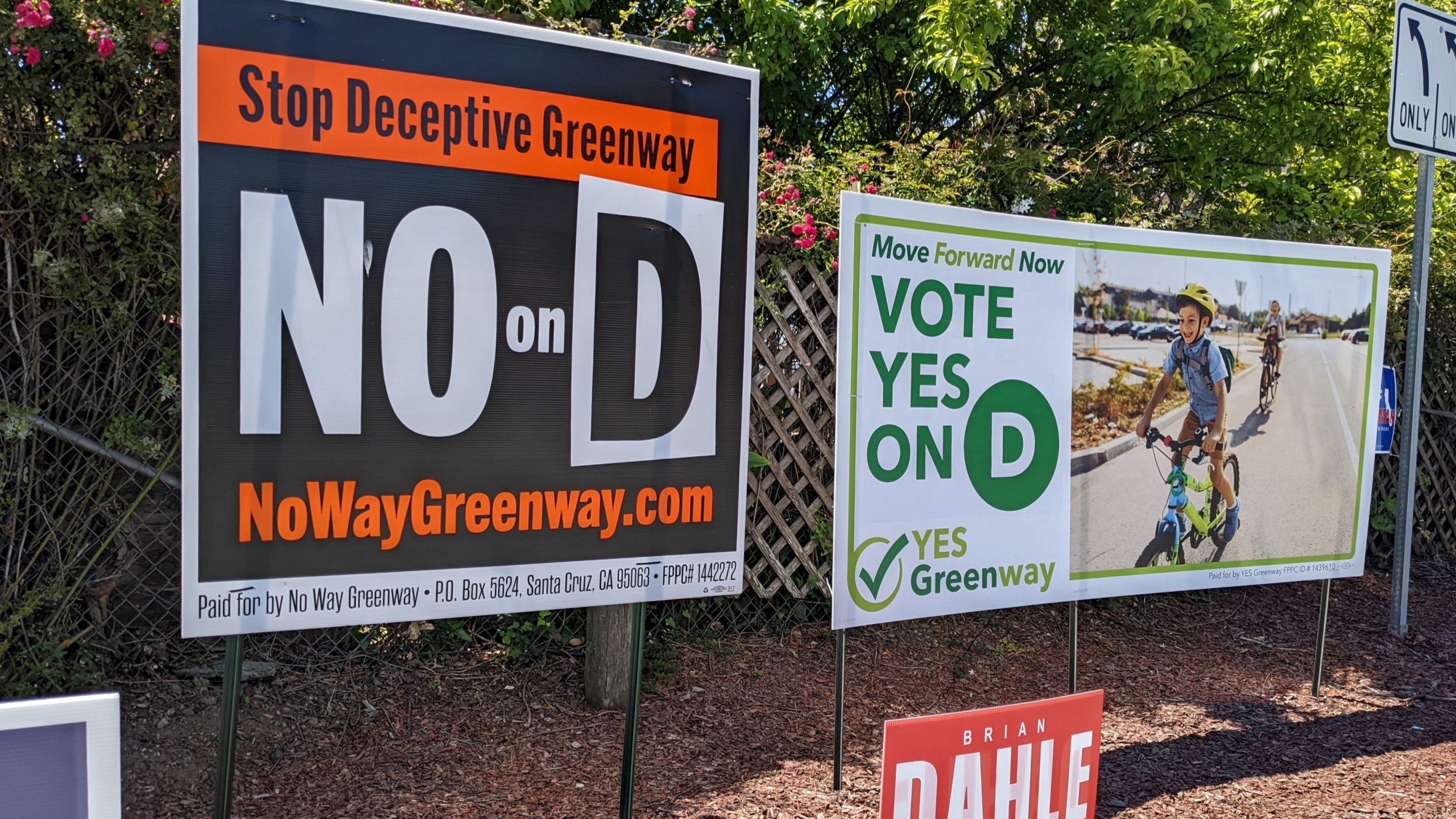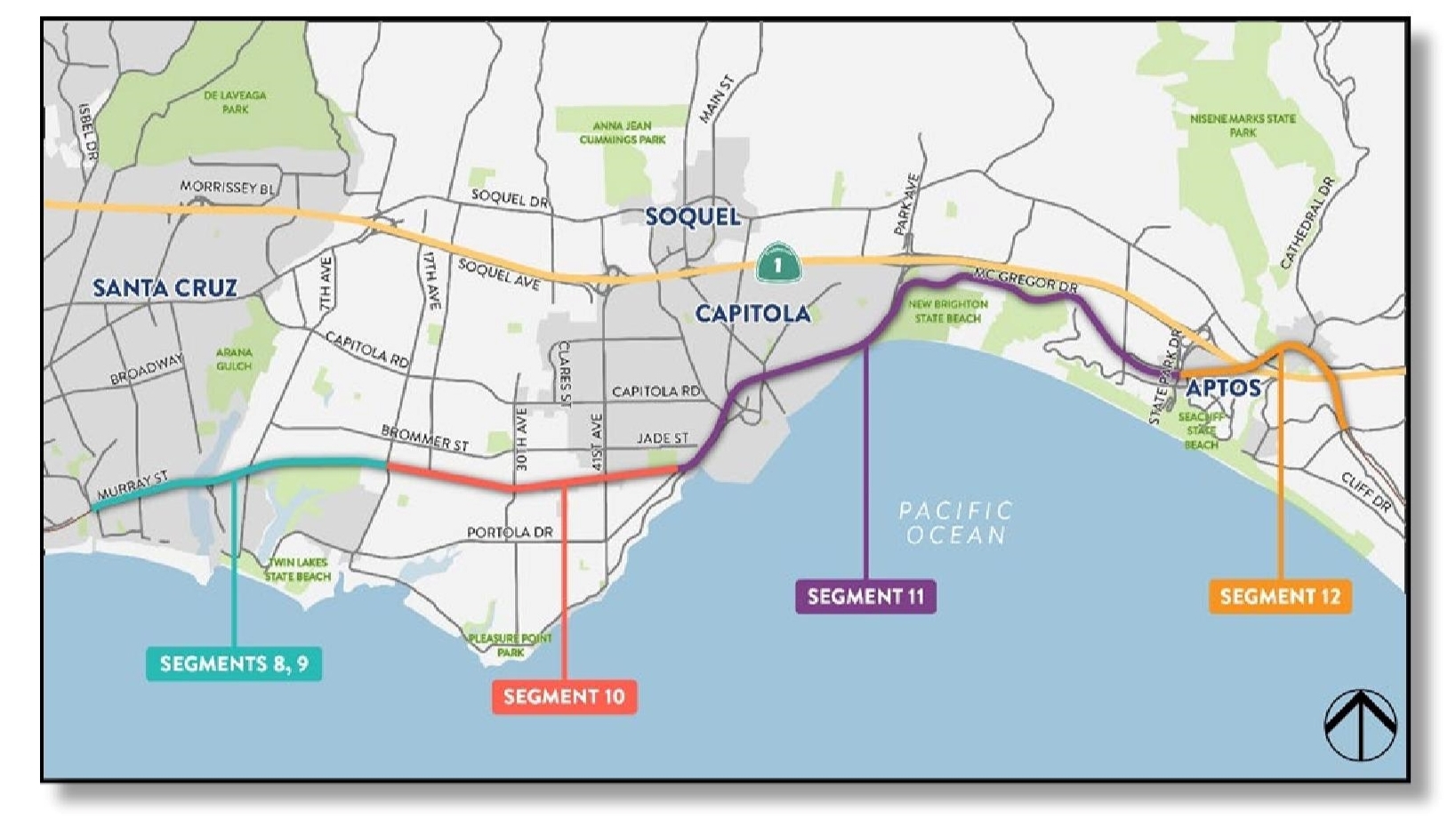Read Santa Cruz Local's Election Guide

Signs in favor of Measure D and against it vie for drivers’ attention near Soquel Avenue and Highway 1 in Santa Cruz in May. (Stephen Baxter — Santa Cruz Local)
What is Measure D?
Passage of Measure D would change the County of Santa Cruz’s General Plan to promote Greenway’s vision for a trail: two lanes of bike traffic, a divider and a walkway. Current plans call for a shared walk and bike path on the rail line or next to the rail line. Measure D needs more than 50% of the vote to pass.
What does a “yes” vote on Measure D mean?
Measure D proposes changes to the County of Santa Cruz’s planning language toward a paved bike and walk path on the Santa Cruz Branch Rail Line. It takes out language in the General Plan related to “passenger rail service.”
If voters approve the measure, it would not force construction of a path on the rail line, nor would it rule out the possibility of future passenger rail service on the rail corridor, according to a county report released in March. Regardless of the outcome of Measure D, the Santa Cruz County Regional Transportation Commission will vote on path designs.
What does a “no” vote on Measure D mean?
A “no” vote on Measure D would keep the status quo and not change the County of Santa Cruz’s General Plan. It would keep the current language that includes planning for potential passenger rail service on the Santa Cruz Branch Rail Line.
Legal opinions on the outcome of Measure D
Measure D is a symbolic vote. That is the legal opinion of leaders and attorneys from the Santa Cruz County Regional Transportation Commission, the County of Santa Cruz and Greenway representatives who initiated Measure D.
“We think this vote is largely advisory and not prescriptive,” said Jason Hoppin, a spokesman for the County of Santa Cruz. Hoppin spoke on behalf of Santa Cruz County Counsel Jason Heath. “The significance of the vote is what the people say: How many people are on one side or the other,” Hoppin said.
Another factor is that the Santa Cruz County Regional Transportation Commission owns the rail line, not the County of Santa Cruz which is a separate agency. If the county’s General Plan is changed by Measure D, that does not legally decide whether there will be passenger rail on the rail line, attorneys for the county and transportation commission said. No Way Greenway representatives believe Measure D’s legal effects are further reaching. Mark Mesiti-Miller, the co-chair of the No Way Greenway campaign committee, said he believed that the changes to the county’s General Plan would be legally binding ways to prevent the county from planning for passenger rail.
Measure D’s passage also would not stop planning for the rail trail or passenger rail, said Santa Cruz County Counsel Jason Heath and Regional Transportation Commission attorney Steven Mattas. Decisions on planning for the rail trail and passenger rail will be made by a majority vote of members of the Regional Transportation Commission, Heath and Mattas said.

Versions of a bike and walk path are being designed along the Santa Cruz Branch Rail Line from Aptos to Santa Cruz. (Santa Cruz County Regional Transportation Commission)
Plans for rail trail regardless of the outcome of Measure D
Transportation planners are moving forward with a plan to build some version of a rail trail from Watsonville to Davenport regardless of the outcome of Measure D. A segment from Natural Bridges Drive to Bay Street in Santa Cruz was completed in 2020.
Planners from the City of Santa Cruz, County of Santa Cruz and RRM Design Group have publicly shared two options for the rail trail from the San Lorenzo River in Santa Cruz to Seacliff.
- An “ultimate” plan would build a paved bike and walk path parallel to the railroad tracks and leave the tracks intact for future passenger rail service.
- An optional “interim” plan would remove the tracks and build a paved bike and walk path on top of where the rails now stand. The plan later is to return the rails for passenger rail transit. However, many rail supporters believe that building a path on the rail line will make it difficult or impossible to create a passenger rail system because of costs, legal reasons, political will and other factors. Building the trail twice with the interim plan is more expensive in the long run, everyone involved said.
Regardless of the outcome of Measure D, county planners plan to collect input on plans for segments of the rail trail from 17th Avenue in Live Oak to State Park Drive in Aptos through early June.
- View designs and information on versions of the proposed rail trail in Santa Cruz and Live Oak.
- View designs and information on versions of the proposed rail trail in Live Oak, Capitola and Seacliff.
Santa Cruz Local stories on the rail trail and Measure D
- Rail trail options outlined in Live Oak, Capitola, Seacliff – April 29, 2022
- Explainer: Santa Cruz County’s rail-trail ballot measure – April 8, 2022
- Rail trail plans detailed from Boardwalk to 17th Avenue – April 1, 2022
- Rail trail ballot measure outlined by Santa Cruz County staff – March 4, 2022
- Rail trail plans detailed from Santa Cruz to Aptos – Feb. 18, 2022
- Explainer: Roaring Camp and freight rail in Santa Cruz County – Feb. 1, 2022
—Stephen Baxter
Santa Cruz Local’s news is free. We believe that high-quality local news is crucial to democracy. We depend on locals like you to make a meaningful contribution so everyone can access our news. Learn about membership.
